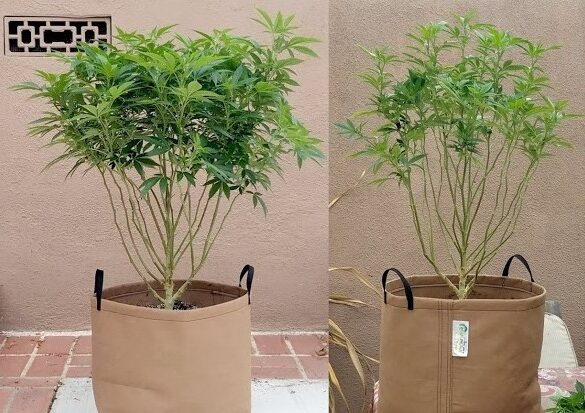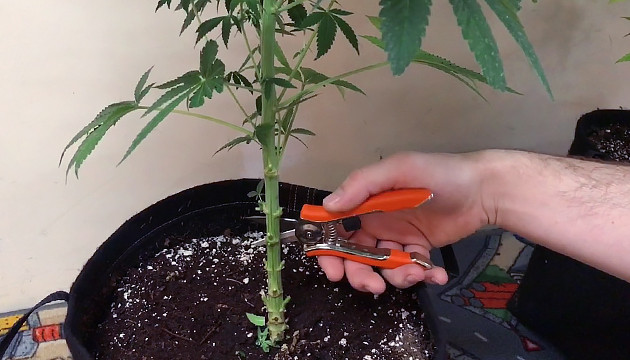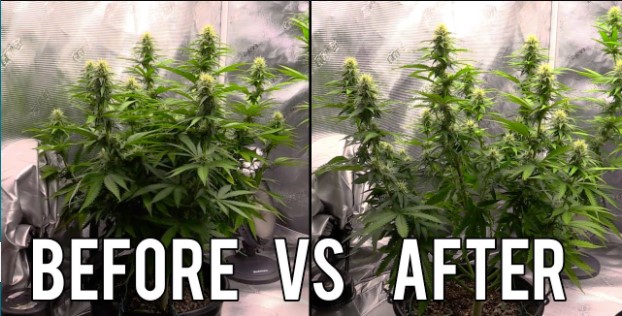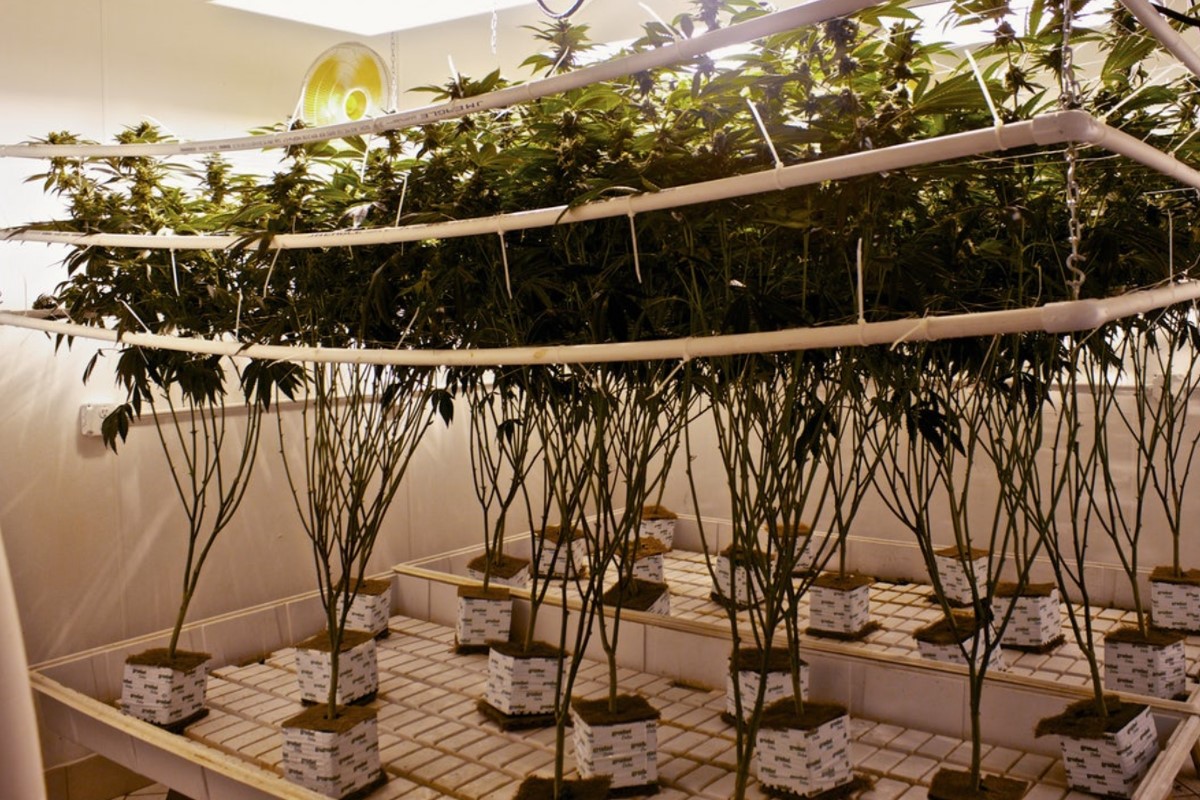Cannabis “defoliation” is the process of removing leaves from the cannabis plant. Some growers call this “lollipopping” when applied to the lower part of the plant. Many growers believe that defoliation can be used as a tool to increase yields when growing indoors. However, there are also some growers who say that removing leaves from cannabis plants negatively impacts yields. In this guide to defoliating cannabis, we’re going to show you that defoliation actually works and can increase yields.
Defoliating a cannabis plant is the strategic removal of leaves to “affect” the plant’s natural processes to produce higher yields.
However, defoliation is not for everyone and is not suitable for all growing conditions. This should also only be used in certain situations. If defoliation is done incorrectly, it will do more harm than good to the plant and reduce yields. As an example, defoliation is not effective for significantly increasing the yields of cannabis plants grown outdoors. When growing indoors, however, properly performed cannabis defoliation results in higher yields.
For those who claim that defoliation can’t have a positive effect on the plant, it should be said that cannabis isn’t the only plant that rewards you with higher yields and higher quality through defoliation.
Some commercial crops, such as cotton, need to be defoliated during their cultivation to achieve the highest yields and quality. In fact, even after 40 years of intensive studies on cotton defoliation, controversies still exist.
Black-eyed peas and some palms are other plants that produce better yields in response to careful defoliation. But again, yields are lower if too many leaves or leaves are picked at the wrong time.
I think these examples demonstrate the most important thing to remember:
Defoliation is definitely not a magical way to increase cannabis yields. It’s a technique like any other and can be done in both good and bad ways.
Now let’s see how to properly perform cannabis defoliation.
Note: Cannabis defoliation works best when combined with other cannabis plant training methods such as topping (pruning of the upper shoots) or LST (Low-Stress Training).
Cannabis Defoliation in the Vegetative phase

Some growers say that defoliating cannabis in the vegetative stage can only harm the plant. They believe that removing leaves only hampers the plant from growing.
In our experience, we believe that defoliation gives the grower better control over growth (plant structure). It also stresses the plant in just the right way to force growth. But only in the places where you want it!
Well, we wouldn’t recommend anyone to take defoliation to the extreme unless they are a very advanced grower who already understands their plants very well.
In general, most growers usually get better yields by leaving all the bud sites alone and only removing the leaves.

Here is a closeup of a defoliated plant. The breeder wanted 8 main colas on the plant, with no small airy buds at the bottom. Therefore, all leaves and also bud sites on the lower part of the plant were removed, leaving only the upper part of the plant to encourage the growth of large bud sites in this area.
However, in our experience, this grower could have achieved even higher yields by leaving all the bud sites on the plant and just removing the foliage.
The top buds (main colas) would have been the same. But the buds on the lower part of the plant would also have developed without affecting the yield of the top buds. This would have allowed you to get more out of the grow setup.
Two weeks later a defoliated plant will have outgrown an untouched plant and has a better plant structure to use the light from the grow lights more efficiently.
This defoliated plant has no buds at the base of the plant trying to form bud sites. The only bud nodes left are the ones the grower wants to grow into the main colas.
This type of structure provides the perfect flowering shape for indoor cultivation, where the main colas stretch upwards and become a series of buds.
Why defoliate in the veg phase?
1. To prevent mould growth
In a plant with leaves, the inside can get very humid and water droplets can even form on the leaves. Defoliation can help prevent mould growth during the growing season.
2. Faster growth of desired plant parts
You’ll get rid of unwanted parts of the plant and the rest of the plant will grow faster in response. Since it doesn’t need to distribute its energy, the plant can focus energy on the desired parts of the plant.
3. Structure the plant to make better use of grow lights
Defoliation can help create a better plant structure for indoor growing. The entire growth can be shifted to the main buds and no energy is wasted on the small and insignificant lower flowers.
4. This makes it easier to train the plants
Removing leaves can make it easier to train plants with LST (Low-Stress Training). Defoliation is absolutely essential for advanced growing techniques like scrog and manifolding.
When to defoliate in the veg (checklist)
- The plant has multiple growth nodes (bases of leaves and stems) and is no longer a seedling or young plant
- The plant is healthy and growing fast
- It is a robust strain
- The plant has so many leaves that the leaves overlap, especially in the middle of the plant
- Leaves prevent light and air circulation from getting inside the plant (see image below for an example)
- These plants in the veg stage are so bushy that the bottom of the plants is completely shaded. These plants should be defoliated for best growth and to prevent mould from developing in the center of the plant.
When not to defoliate in the veg phase
- The plant is not healthy or growing slowly
- The strain is known for being picky and difficult to grow
- The plant does not have many leaves/dense foliage
- You are a newbie to cannabis plant breeding
Cannabis Defoliation, Which leaves to Chop
When defoliating in the vegetative stage, you should first remove annoying fan leaves (large leaves with many “fingers”). You should remove overlapping leaves (which lead to damp patches that can lead to mould). If possible, try to remove the leaves lower down on the plant and in the middle of the plant.
Avoid removing the outer and top leaves. These should already get a lot of light and do not need to be removed. You want a plant with leaves around the outside and fewer leaves in the middle or bottom.
When defoliating, remove no more than 20% of the leaves in one sitting. If you are new to defoliation, it is recommended that you remove fewer leaves at a time and defoliate over a few weeks. Leave at least a week between the processes of defoliation. Taking out too many leaves in a short period of time can cause your cannabis plant to become very stressed and stunted.
When defoliating, you should work on creating the right structure for your plant. Indoor growers generally want lots of colas (flower sites) to increase yield, and defoliation can help create a desirable structure.

Indoor growers usually want lots of colas on their plants to get the most out of their grow lights. However, in order to achieve the largest bud sites, competing plant parts on the plant must be selected. This means you need to remove the shoots/leaves/bud sites that form those bud sites that are unwanted.
Note: Removing shoots is not technically defoliation, but is part of pruning. However, this technique works well with defoliation (and involves removing leaves).
How to make more colas during veg stage defoliation
A good rule for indoor growers is to force the growth of 4 to 8 main colas (buds) directly under lights. For smaller plants, you may want to force fewer main colas and for larger plants more colas.
To force main colas to grow, which become fat and dense, you should remove smaller buds so they don’t steal energy from the main buds. To do this you should remove undeveloped colas/growth tips.
This starts by looking at your plant and examining its structure to see which colas appear to have the most dominant branching. You’re looking for colas with a thick joint at the base, with lots of knots at the top of the stem. These knots form the buds, which should be under plenty of direct light.
Flowers form only at the nodes (nodes) of a stem (where the fan leaves emerge). So if you have a lot of space between the nodes (nodes), you will end up with fewer flowers. Because of this, it’s important to get rid of those slender, lanky stems and encourage growth in the main colas with closely spaced nodes.
The growth tips that you leave alone will become the main colas/bud sites. Once you’ve figured out which growth tips/shoots will become your main colas, it’s time to start defoliating!
When your plant is so bushy that light isn’t getting through the plant to the ground, it’s time to “clean” the lower part of the plant of leaves.
Start by removing any small growth tips/shoots at the bottom that will never be able to get enough light anyway. These only grow into delicate/small buds at best, and you don’t want those tiny buds draining energy from the plant that could flow into the main buds.
Next, remove long, stringy stems with wide spaces between nodes (knots). These will never make good colas as they can only flower on the few nodes they have and should generally be discarded.
Remove stems with few nodes, especially if the stem hasn’t made it to the top of the plant where the light is.
Now look at your plant and study its structure. Determine which stems you want to keep for the main colas. You should go for at least 4 main colas when growing indoors. Check which parts of plants you need to remove that are competing for light and space with these main colas.
What happens after defoliation in the vegetative stage
If you follow all of the above instructions, the remaining parts of your plants will grow faster and will immediately start growing new leaves on the main colas you designate.
This faster growth leaves you flowering earlier and with an advantageous structure to make more efficient use of the grow lights you use.
Lateral growth of the plant will increase, making the plant wider and less tall, while there will be no growth at the bottom of the plant, which will sap energy from the upper buds.
Cannabis Defoliation in the flowering phase

Cannabis plants seem to expend the most energy on buds that are exposed to light, and these are the buds that grow the largest and most dense. Because of this, buds that aren’t easily visible and are in the middle or bottom of the plant never seem to fully plump. They get far too little light.
Why should you defoliate in the flowering phase?
Helps prevent mould and bud rot on cannabis plants, not only, but especially during the flowering phase by reducing humidity in the plants, on the leaves and in the grow room.
Bigger Buds and Yields: Buds that get more light and air will thicken faster, larger and therefore produce larger yields than buds that get less light and air.
When should you defoliate in the flowering phase?
- If grown indoors using bright grow lights.
- When the plants are healthy and growing fast.
- If the plant has grown without problems and is robust all its life.
- When the plant is so leafy that the leaves are overlapping and/or when some flowers are covered by the fan leaves (the large leaves) and are not getting any light.
When not to defoliate in the flowering phase?
- If the plants are not healthy or growing slowly.
- The plants have been struggling in the vegetative (growth) phase ( they may be too sensitive to respond well to defoliation).
- The plants do not have many leaves. If you can see sideways through the plant to the other side and/or if light can penetrate to the ground below the plant, you probably don’t need to defoliate.
- Buds already get enough light and air (buds are not obscured by fan leaves).
When should you defoliate (timing) in the flowering phase?
There are some basic ideas about when to defoliate in the flowering phase. We will share some with you:
Defoliate the plant just prior to switching from veg to flowering, then defoliate again at week 3 of the flowering phase. We do this with photoperiod plants and have had good results with them. If you’re not sure when to start defoliating, here’s how to do it.
Defoliation in weeks 3 and 6 – Some growers prefer to delay the timing of defoliation by 3 weeks and avoid defoliation early in the flowering phase. In this case, the first defoliation would occur at the end of week 3 of flowering, then a second defoliation at the end of week 6 of flowering.
However, most growers don’t have a specific schedule and instead defoliate throughout the flowering phase, removing leaves when the plant is very leafy, or when they notice leaf stacks or buds being covered.
Which leaves to remove/defoliate in the flowering phase
The main goal of defoliation in the flowering phase is to expose all main buds to light and air. Exposed buds simply grow faster and thicken faster than buds covered by leaves.
As in the veg stage, you should still remove any leaves that are on top of each other and focus on removing the lower leaves (larger fan leaves only) of the plant. This defoliation reduces the likelihood of mould and helps release energy that is channelled into the main bud sites (colas).
In particular, you should remove any large fan leaves near the top of the plant that hides the buds underneath from light exposure. Also, a fan leaf that is yellow doesn’t really have anything to offer the plant anymore.
As always, never cut off so many leaves from the plant that you can see through the entire side of the plant. Plants that are well into the flowering stage will almost never develop leaves, so any leaves you remove from the plant will be the last ones the plant will have for the rest of its life!
Removing too many leaves during the flowering phase, especially in the last few weeks, can have the opposite result and have a negative impact on yield. And that’s not the point!

